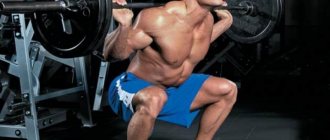Have you been pumping your biceps in training for a long time, but are not satisfied with their strength and volume? After reading this article, you can achieve the desired result.
Training program for increasing muscle mass in the biceps of the arm
For most people who start working out in the gym, the main goal is huge biceps, developed chest and six-pack abs.
Are you trying to build powerful biceps but not getting the desired results? All your efforts are frustrated by the harsh reality and mistakes you make when creating a training plan. Next, you will learn what you need to do to start growing biceps without using steroids.
Biceps muscle anatomy
The biceps consists of two heads:
- Biceps brachii muscle. Located on the outer part of the arm. This muscle works when performing almost any biceps exercise;
- Brachial muscle. Located on the inside of the arm, deeper than the biceps muscle. With a developed brachialis muscle, there is a clear separation between the biceps and triceps. Also, with the growth of the brachialis muscle, an increase in the peak of the biceps is observed.
Functions of the biceps:
- Flexion of the forearm at the elbow joint;
- Flexion of the shoulder at the shoulder joint.
Biceps workout
There are many theories on how to build biceps. This is not to say that they are all wrong, but from each statement you need to highlight the best and create the only correct biceps training program.
- 1. Many people believe that doing basic exercises is enough to stimulate biceps growth.
Indeed, heavy back exercises involve the biceps. But this is not enough to form the required volume of the target muscle - isolation exercises are needed.
- 2. Heavy lifts with barbells and dumbbells are the best exercises for developing biceps. High-repetition exercises can be included in a training program, but they cannot replace heavy training.
- 3.One biceps workout per week is enough to start muscle growth. You shouldn’t work your butt off, pumping up your biceps every workout - at this pace, the muscles won’t have time to recover.
- 4.Focus on a certain number of repetitions per week.
In this case, an immutable rule applies: the heavier the working weight, the fewer repetitions you can perform. You must keep this balance in check to avoid overtraining. This is especially true for exercises like deadlifts and squats, as you will need a lot of recovery time.
The optimal number of repetitions when working with a weight of 80-85% of the one-rep maximum is 60-70 times a week. This system applies not only to training biceps, but also other muscle groups.
Please note that the biceps work when training other muscle groups. So don't do another 60 reps that focus solely on your biceps. This will be too much - overload cannot be avoided.
Optimize your biceps reps and get them down to 30-40 per week.
If your biceps stubbornly refuse to grow even after all the above recommendations, then try the following system:
- Horizontal block thrust
9 heavy sets of 4–6 reps;
- Standing biceps curl
3 sets of 8–10 reps;
- A few days later, perform barbell curls again (6 heavy sets).
This method will give a powerful impetus to the development of biceps, and will also help avoid a period of stagnation and provoke muscle growth.
Now let's look at the best exercises for growing biceps.
Basic exercises
Basic exercises for biceps - lifting barbells or dumbbells. The type of apparatus and grip determines exactly how the muscle is involved in the work - for example, dumbbells can be lifted either with the palm facing the ceiling or with the palms parallel to each other (pictured above).
The main secret of the technique is that when training biceps, the elbows should be motionless (beginners are recommended to press them to the belt), and the body should not sway from side to side. Plus, the speed of lifting and lowering the weight should be slow enough to perform the exercise consciously.
// Read more:
- best biceps exercises
How often should you download?
If you want to pump up your biceps as quickly as possible, train them twice a week - for example, on Monday and Friday. Start your workout with exercises for large muscle groups (back, chest, legs), and after 3-4 multi-joint exercises, move on to targeted biceps training.
As multi-joint exercises, training on a horizontal bar or with a kettlebell can be used. They are not only useful for overall strength gain, but also improve posture, put stress on the core muscles, strengthen the abs and make the figure more athletic.
The best biceps exercises
You don't have to do dozens of exercises with numerous sets and repetitions. There are many exercises for developing biceps, but only a few of them work.
1.Biceps curl
It is considered one of the main and effective biceps exercises.
This exercise can be performed standing with an underhand or overhand grip, as well as sitting in a Scott bench;
2.Biceps curl using an EZ bar
A great exercise that will not only give a boost to the development of your biceps, but will also relieve tension from your wrists;
3. Alternate lifting of dumbbells for biceps;
4. “Hammer” (Lifting dumbbells for biceps)
This exercise can be performed by lifting dumbbells either together or alternately;
5. Reverse grip pull-ups to chin level
An exercise that makes not only the biceps work, but also other parts of the body. If it is easy for you to perform this exercise with your own weight, then you can use weights.
Training Tips
Warm-up
Warm up properly, spend at least 5 minutes on this. Stretch well and get the blood flowing.
Sets and reps
The number of approaches is from 2-3 for each exercise. The number of repetitions is from 6-12. Focus on your own feelings and select the weight so that you can finish the set 1-2 repetitions before failure.
How often to pump your biceps
Two three times a week. No more and no less. We don’t overload the biceps, otherwise goodbye progress and hello injuries.
Why do my biceps hurt after training?
Muscle pain after exercise is normal. The growth process begins after the muscle is damaged during work. Through growth, the body compensates for these gaps and adds a little on top to better cope with the load next time. The pain usually goes away after a few weeks, and the very fact of discomfort means that the muscles are adapting to the load.
What to do if I can’t straighten my arms after biceps training
If your arms do not straighten, the reasons may be the following: you have rested for too long and the muscles have become unaccustomed, or you have gone too far with the loads. There is nothing wrong with this; beginners often feel this way after their first training sessions. After a couple of weeks, the discomfort most often disappears.
Nutrition and sports supplements
If you want a big bitsukha, eat a lot of protein and carbohydrates. And drink plenty of water. From sports nutrition - amino acids, protein, creatine will help you. All this will help build high-quality muscle mass.
Increase the load
In order to start the process of muscle growth, you must increase the working weight of the equipment. The fact is that the body skillfully adapts to monotonous loads, which stops muscle growth. You need to shock the muscles so that they take the path of progress and development.
It is important to remember that the load must be increased gradually to avoid the possibility of injury.
If you follow this advice and remember to eat right, your muscles will definitely grow. This rule applies not only to the biceps, but also to all other muscle groups.
Biceps training program
A productive workout includes exercises that can pump up all the components of the biceps muscles.
Be sure to warm up before exercise. This will allow you to warm up your entire body and prepare it for the upcoming stress.
- Barbell curl
3 sets of 4–6 reps;
- Hammer dumbbell curls
3 sets of 4–6 reps;
- Dumbbell biceps curl
3 sets of 6–8 reps.
Don't be surprised that you only need to do 9 bicep curls for the entire workout. There is no need to lift weights to the point of exhaustion.
Over the next 8 weeks, try the training program described above for yourself and see if it really works.
After 8 weeks, modify your training program slightly to include other exercises.
- Reverse grip pull-ups
3 sets of 6–8 reps;
- Barbell curl using an EZ bar
3 sets of 4–6 reps;
- Hammer dumbbell curls
3 sets of 6–8 reps.
Alternating the type of load is necessary for the muscles to continue to grow.
How to pump up your biceps to gain mass
It is important to understand that the issue of pumping up biceps is not so much doing physical exercises, but rather a combination of key conditions and factors:
- Proper nutrition with a calorie surplus and sufficient intake of amino acids from protein foods.
- Muscle recovery.
- Control of training volume by week or cycle in the program.
One of the most popular mistakes is excessive attention to working out the zone and the desire to get quick results. Athletes want to see the results of their efforts and train their biceps at least 2 times a week. Moreover, the biceps takes part in other exercises, especially deadlifts. As a result, athletes overtrain and stifle their muscle growth potential.
It is important to remember that biceps “do not like” processing. Like other areas, the biceps muscle needs rest.
Another aspect worth paying attention to is the operating mode. Some athletes get significant growth from high-repetition training and pumping, others from powerful strength work for 5-8 repetitions per set. It is impossible to predict which regimen will be best for a particular athlete. This needs to be determined experimentally or a laboratory analysis done to determine the ratio of fast and slow muscle fibers in the biceps (which for most people will be unreasonably expensive and unnecessary).
Selection of optimal projectile weight
- If you can easily do the maximum number of repetitions required for a particular exercise, or even more, then you should increase the weight of the apparatus;
- If you are unable to get close to the lower limit in the number of reps required, then you are using too much weight. Reduce it and perform quality work with optimal weight;
- Add weight only if you can confidently perform the maximum number of repetitions required for a given exercise with the working weight. For example, if you did 8 reps on a 6kg dumbbell curl, then pick up the 8kg dumbbells and keep going.
If you can’t even do 4 repetitions with the new weight, then you obviously rushed to increase the weight, overestimating your capabilities. Go back to the old weight and work with it for a while.
There is nothing wrong with trying to lift more and more weight. The main thing is to do it wisely.
How to pump up your biceps?
Anyone who decides to pump up their biceps muscles will have to follow three main rules:
- exercise regularly;
- Healthy food;
- give the body time to recover.
Workout
The volume of muscle tissue directly depends on the weight you lift. The more intense the workout, the faster the muscles will grow. But don't rush off the bat. The load should be dosed, and you should start with the weight that you can lift without harming your health.
Intensity of training - increasing the load, is achieved not only by increasing weight. They also help:
- increasing the number of repetitions;
- performing slow repetitions;
- performing negatives;
- performing repetitions without rest.
If you start increasing repetitions, do it without fanaticism. The ideal option is a maximum of 15 repetitions. Slow repetitions involve lifting a barbell or dumbbells for 10 seconds. Negatives are a slow lowering of the load, also for 10 seconds, while lifting is done at a normal pace and with the correct technique. You need to do up to 5 repetitions. If they are easy, you should increase the weight.
Let's look at 5 basic exercises that allow you to pump up the desired muscle:
- bend your arms while holding the barbell (standing position);
- bend your arms on a Scott bench;
- “hammer” with dumbbells;
- lift dumbbells (also done while standing);
- bend your arms at an angle (performed on a bench).
For those who want to build biceps quickly, curling their arms while holding a barbell is the best thing they can do for themselves. Beginners will have to work hard, but the results are worth it. Stand straight, place your feet shoulder-width apart, hold the barbell in your arms. Raise it, describing an arc in the air. Ideally, it should be brought as close to the chest as possible.
Barbell curls performed on a Scott bench will place stress on the lower biceps and lengthen the biceps muscle. Take a barbell (EZ bar), wide grip. As you make an arc in the air, lift it so that you almost touch your biceps. Then lower it slowly.
Hammer with dumbbells is another exercise that promotes rapid growth of the biceps muscle. Stand straight, bend your knees slightly, hold dumbbells with your arms down so that the inside of your palms are pressed to your body. Without changing the position of your hands and elbows, lift the dumbbells. In this position they should be as close to the shoulders as possible. Then return to the starting position. The exercise should not be performed jerkily, but smoothly
Lifting dumbbells while standing is one of the basic exercises and is similar to a barbell exercise. Stand straight with your feet shoulder-width apart. Dumbbells - in lowered hands. Raise the dumbbells, describing an arc in the air, but do not lift your elbows from your body.
If desired, you can perform the following biceps exercises during your workout:
- pull-ups with weights – 2 sets of 8-12 times;
- barbell curls – 2 sets of 6-8 times (+ negatives);
- wrist curls with heavy weight – 2 sets.
Result
The described exercises will help you quickly pump up your biceps. If time passes and no positive changes are noticeable, the cause may be poor development of “secondary” muscles. As we already mentioned, without a strong brachialis it is impossible to get beautiful hands. But besides this, triceps and deltoids are also important. If they are poorly developed, the body triggers a self-defense mechanism, preventing sprains and damage to muscle tissue.
In this case, the following program can help (it is designed for a three-day workout):
first day - the load is created on the brachialis
- lat pulldown, parallel grip - 2 sets of 8-10 reps;
- barbell curls, performed on a Scott bench - 2 sets of 8-10 repetitions;
- Barbell curl, overhand grip – 1 set, 8-10 reps.
second day - the load is created on the deltoid muscles
- work with dumbbells (spread to the sides and perform power swings) – 2 sets of 8-10 repetitions;
- Bent-over rows, elbows out to the sides - 2 sets of 8-12 repetitions;
- bending the arms at the wrist joints, heavy weight – 2 sets of 6-8 repetitions.
or
- squats with a barbell – 2 sets of 20 reps;
- barbell row to the chin, wide grip – 2 sets of 8-10 repetitions;
- Bent-over rows, elbows out to the sides - 2 sets of 8-12 repetitions.
the third day the load is created on the triceps
- squats with a barbell – 1 set of 8-10 reps;
- bench press, close grip – 2 sets of 8-10 reps;
- swings in front of you - 2 sets of 10-12 repetitions.
or
- bench press, close grip – 2 sets of 8-12 reps;
- arm extension on a block, underhand grip - 2 sets of 8 reps.
The described exercises are performed with a barbell or dumbbells. Is there a significant difference? Which projectile is better to choose? Both are needed. Barbell work should be done at the beginning of the workout. It is desirable that the weight is not small. Exercises with dumbbells will be needed to “drawing” the relief. In addition, they will help you feel the work of your muscles.
Proper nutrition
Gaining muscle mass largely depends on proper nutrition. Consuming the right amount of proteins, fats and carbohydrates, eating in such a way as not to disrupt metabolism is important for any athlete, not only for a boxer or bodybuilder.
So, in order not to disrupt your metabolism, you need to consume 2 g of protein per 1 kg of weight daily. If your goal is to build muscle mass as quickly as possible, then in addition to intense training, you will have to increase your daily protein intake to 6 g per 1 kg of weight.
Recovery
Every workout is stressful not only for the muscle tissue that is injured, but also for the nervous system. This is why you can’t train every day, your body simply won’t have time to recover. If you manage to exercise often and your workout lasts a long time, then the load is small. As a result, you won’t be able to build up your muscles, but “overtraining” can manifest itself in this case too. You may simply burn out.










